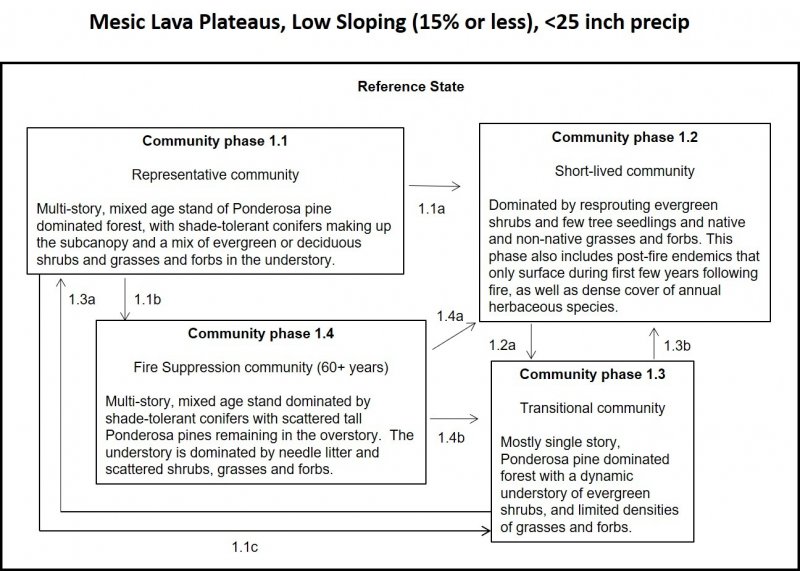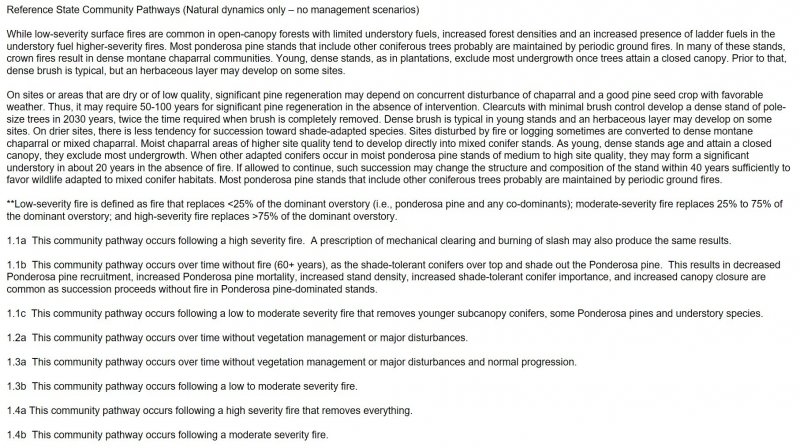Ecological site group F022BG201CA
Mesic Ash-Influenced Mountains
Last updated: 03/01/2021
Accessed: 12/21/2025
Ecological site group description
Key Characteristics
None specified
Provisional. A provisional ecological site description has undergone quality control and quality assurance review. It contains a working state and transition model and enough information to identify the ecological site.
Physiography
This ESG is most typically found on the backslopes, shoulders and summits of mountains from 2000 to 5000 feet, but can range from 1200 to 6500 ft. on slopes from 10 to 50% (can be as low as 2% is some cases).
Climate
The average annual precipitation in this MLRA is typically 20 to 65 inches but can range from 13 to 123 inches (176 to 2,471 millimeters). This ESG averages between 35 to 80 inches. It is lowest in the lower valleys and highest on the mountain peaks. The precipitation falls mainly from fall to spring, mostly as snow. Winter precipitation is from Pacific storms that are frontal in nature. The amount of precipitation decreases from west to east. Summers are typically warm and dry, but there are occasional thunderstorms. The average annual temperature is 27 to 61 degrees F (-3 to 16 degrees C). The frost-free period for this ESG is generally greater than 100 days, and the freeze-free period averages 215 days and ranges from 85 to 350 days. The lowest annual temperatures and the shortest freeze-free periods occur in the mountains.
Soil features
The soils for this ESG are deep and very deep, fine-loamy, well drained soils that formed in material weathered from volcanic rock.
Vegetation dynamics
This ESG is part of the Sierran mixed conifer habitat type and is an assemblage of conifer and hardwood species that forms a multilayered forest. Historically, burning and logging have caused wide variability in stand structure, resulting in both even-aged and uneven-aged stands. Virgin old-growth stands where fire has been excluded are often two-storied, with the overstory comprised of mixed conifer and the understory white fir and incense-cedar. Forested stands form closed, multilayered canopies with nearly 100 percent overlapping cover. When openings occur, shrubs are common in the understory. Closed canopy stand distribution is both extensive and patchy depending on scale, site, slope, soils, microclimate, and history.
At maturity, the dominant conifers range from 30 to 60 m (100 to 200 ft) tall with a highly variable basal areas of about 17 to 26 sq m (180 - 280 sq ft). Diameter breast height at maturity for pines and Douglas-fir is commonly greater than 1 m (40 in); white fir greater than 0.9 m (35 in) is common. Fuel loading in stands heavy with pine may reach 27,000 kg/ha (70 to 80 t/ac) in natural stands; whereas fuel loading in stands heavy with fir may reach 16,000 kg/ha (40 to 50 t/ac).
Five conifers and one hardwood typify the mixed conifer forest white fir, Douglas-fir, ponderosa pine, sugar pine, incense-cedar, and California black oak. White fir tends to be the most ubiquitous species (though most often a minor overstory component) because it tolerates shade and has the ability to survive long periods of suppression in brush fields Douglas-fir dominates the species mix in the north, but is absent south of the Merced River. Ponderosa pine dominates at lower elevations and on south slopes. Jeffrey pine commonly replaces ponderosa pine at high elevations, on cold sites, or on ultramafic soils. Red fir is a minor associate at the highest elevations. Sugar pine is found throughout the mixed conifer type. Black oak is a minor, but widespread, component in mixed conifer stands. Though black oak does best on open sites, it is maintained under adverse conditions such as shade, ridge tops, and south slopes where conifers may regenerate in its shade. This ESG is primarily dominated by white fir, ponderosa pine, Douglas-fir, incense cedar, snowbrush, squaw carpet, manzanita and bottlebrush squirreltail.
California Wildlife Habitat Relationships System
California Department of Fish and Game
California Interagency Wildlife Task Group
Barbara H. Allen (2005)
This ESG is most commonly dominated by ponderosa pine, Douglas-fir, white fir, sugar pine, and incense-cedar with scattered black oak. Shrubs are prostrate ceanothus, whiteleaf and greenleaf manzanita, and deerbrush.
FEIS. Pacific Ponderosa Pine, https://www.fs.fed.us/database/feis/plants/tree/pinponp/all.html. Accessed September 28, 2020.
California Wildlife Habitat Relationships System
California Department of Fish and Game
California Interagency Wildlife Task Group
E. Lee Fitzhugh
Major Land Resource Area
MLRA 022B
Southern Cascade Mountains
Stage
Provisional
Click on box and path labels to scroll to the respective text.

